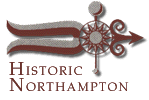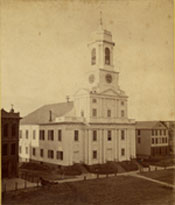

|


Sally Maminash: Last of the Indians Here
by Margaret Bruchac
 |
Gravestone of Sally Maminash Bridge Street Cemetery |
Sally Maminash (alternately spelled Mammanash, Mammanache, etc.) is buried in Northampton’s Bridge Street Cemetery, where her gravestone, situated in the family plot of Warham and Sophia Clapp, reads: “Sally Maminash. The last of the Indians here. A niece of Occum. A Christian. Died in the family of Warham & Sophia Clap. Jan. 3, 1853. Aged 88.”
A collection of fading newspaper clippings from the Daily Hampshire Gazette adds a few more tragically cryptic details to Sally’s story--her father Joseph’s gravestone stolen from a “lonely grave on Pancake Plain,” her mother Elizabeth “stoned to death by local boys,” her dying brother “neglected and alone,” her grandmother “old, lousy and lame,” and Sally herself, a “wild, passionate, wilful” girl who worked as an itinerant spinner and weaver, transformed into a “sweet, saintly Christian,” sitting peacefully in her chair reading her Bible.1
Almost every town in New England had an individual who was described as “the last of the Indians,” a popular, if somewhat misleading sobriquet. Molly Ockett, an Indian Doctress who was survived by several daughters and an ex-husband, was called “the last of the Pequawkets” when she died in 1816. In 1859, Eunice Mauwee, a Schaghticoke elder who is the direct ancestor of many members of the Schaghticoke tribe today, was erroneously called “the last of the Pequots.”2 Paine Henries, the so-called last of the Nipmucks, who died in 1936, was survived by two brothers, a sister, and several nieces and nephews.3
 |
Pancake Plain identified on the Plan of the Town of Northampton, 1831 |
In Northampton, the largest concentration of Native peoples seems to have centered around Pancake Plain and Hospital Hill, where the Maminash gravesites were located. Through much of the twentieth century, the site was home to a mental hospital, rural fields grown up to brush, and homeless shelters. Charles Dean wrote, in a 1958 article for the Daily Hampshire Gazette: Hospital Hill, the beginnings of which are either distorted or utterly lost in the mists of legendary lore...became the end of the trail for the last Native Americans, whose ancestors roamed the forests and fished the streams hereabouts before the coming of the white man.…perhaps the most reasonable explanation for the retarded development of this part of Northampton was its remoteness...a narrow flat strip of land lying between the foot of the hill itself and the southern bank of Mill River...but even as late as the 1830s only seven or eight houses were located there, devoid of elegance or comfort, and occupied by person noticeable for the peculiarities, habits, and dress which makes them known as characters.… “Ratty Clark” and family...made a somewhat precarious living as potters.… But the most colorful inhabitant of the plain perhaps, was “Aunt Nab” whom a contemporary once described as a “maker and vendor of cornhusk mats” and as having a “cracked voice and garrulous manner.”4
 |
First Church, built 1812 circa 1872-1876 |
Sally Maminash lived in the center of town, where she was well known to many Northampton residents as an itinerant weaver. In 1816, she joined First Church along with seventy-six other people, including several other Indians and African Americans and a Nipmuc family named Bakeman. By 1819 large numbers of people had left First Church to join new congregations-Edwards Church, the Unitarian Society, Methodists, Baptists, and others. Reverend Solomon Williams recorded Sally Maminash’s name on a “List of Church Members 1819 who were living or have not taken a dismissal” after religious controversy split the congregation.5 Decades after her death, when Solomon Clark compiled his Historical Catalogue, Sally Maminash was described as follows: “Sally Maminash. The last of the Indian race in Northampton; long and tenderly cared for, under the infirmities of age, by Mrs. Warham Clapp, and her son Edward and his wife.”6
Sophia Clapp, who sponsored Sally’s membership in the church, had offered Sally a home in her old age. Although the Clapps treated, and buried her, as a family friend, later writers seem to have embellished the earlier accounts to make Sally appear more simple, more destitute, and more alone than she was in real life. In the Northampton of the late nineteenth century, Sally seems to have been cast as a token civilized Indian, an icon of what was romantically believed to be a vanishing race. The Maminash family were not uncivilized remnants of vanishing tribes–they served as soldiers, weaved in local homes, attended local churches, and participated in the social milieau of Northampton much like their white neighbors. They were, however, vulnerable to racial prejudice and danger from their less tolerant neighbors.
Sally’s father, Joseph Maminash, was identified in colonial records as Podunk, Nonotuck, and/or Pocumtuck Indian, listing places of residence in Norwich and East Windsor, Connecticut, and Southampton and Northampton, Massachusetts.7 The Maminash men, like many Native men in New England, mustered in alongside their white neighbors in local regiments for military service. When Mohegan men from Connecticut were recruited for the English campaign against Louisbourg in 1745, Joseph Mammanash [sic], Sally’s father, joined Nathan Whiting’s 11th company, along with a number of Indian men in this and related companies, including members of the Uncas, Dick, Nanapau, Quaquequid and Wetowomp families.8 When he died in 1767, Joseph was buried on Hospital Hill, in a grave marked with a brown stone bearing the mark of the turtle, the clan totem of the family. During the 1860s, the stone was stolen, and has never been found.9
Sally’s mother, Elizabeth, who was identified as the sister of the Mohegan minister Samson Occum, apparently came from the community of Mohegan Indians in southeastern Connecticut. In 1779, then sixty-year-old Elizabeth met an untimely, as-yet-unexplained death. Some traditions say she was stoned to death by a gang of Northampton boys; others that she died in liquor.10 She was buried beside her husband, and her children took up residence among their Native neighbors.
 |
Sally’s brother, Joseph, served in the military during the American Revolution, and is listed in Massachusetts Soldiers and Sailors as follows: Mamanash, Joseph, Hadley. List of men raised to serve in the Continental Army from the 4th Hampshire regiment as returned by Capt. Samuel Cook; residence, Hadley; engaged for town of Hadley; joined Capt. Shay’s co., Col. Putnam’s regt,; term 3 years; also, Private, Capt. Daniel Shays co., Col. Rufus Putnam’s (5th) regt.; Continental Pay accounts for service from Jan. 15, 1777 to Aug, 31, 1778; reported died Aug. 31, 1778; also, same co. and regt.; return dated Albany, Feb. 9, 1778; mustered by Col. Woodbridge. He, too, is buried in an unmarked grave on Hospital Hill. Among the few artifacts remaining from the Maminash family are Sally’s Bible, stored at Forbes Library, and her favorite chair, a low ladder back with its original ash-splint seat donated by a Clapp descendant to the collection of Historic Northampton.
The Maminash family, although a Native family with deep roots in New England, had “arrived” in the records of Northampton towards the end of the French and Indian wars and the beginning of the American Revolution, the very era when American history was being re-scripted to write Indians out of the picture. Indian deeds had long since been signed, and Northampton’s settlers refused to see the cornfields in the meadows, the graves on Pancake Plain, the basket-makers on the streets, or the houses on the edge of the river as evidence of Native persistence. The neighbors of the Indian graves on Hospital Hill today include homeless shelters, empty homes, a crumbling mental hospital, and the Smith playing fields, on the backside of town. Mary Brewster foreshadowed their present obscurity: The field where the Indians were buried, now owned by the state hospital, was owned by W. F. Arnold who left standing the group of gaunt pines that long guarded the “Indian Grave” in picturesque and poignant contrast to the spot today where, in sunny bleakness below a stone-covered ridge, gone is the last trace of a historic burial place, unmarked and generally unremembered.11
1. Bruchac, “The True History of Sally Maminash”; C. Keith Wilbur, “Land of the Nonotucks” (Northampton, 1987).
2. Trudie Lamb Richmond, “A Native Perspective of History: The Schaghticoke Nation, Resistance and Survival,” in Laurie Weinstein, ed., Enduring Traditions: The Native Peoples of New England (Westport, CT, 1994), 103.
4. Charles J. Dean, “Hospital Hill and Its Riddles of Yesterday,” Daily Hampshire Gazette, November 15, 1958.
6. Rev. Solomon Clark, Historical Catalogue of the Northampton First Church 1661-1891 (Northampton, 1891), 121.
8. Nathan Whiting, List of Soldiers, 1745, from Collections of the Connecticut Historical Society 13:76-80.
9. Sidney E. Bridgeman, “Sally Mammanash Is Recalled Here: Daughter of Indian Woman Who Was Stoned to Death Lived with the Bridgemans,” Daily Hampshire Gazette, August 25, 1936.
10. Dean, “Hospital Hill and Its Riddles of Yesterday”; Bridgeman, “Sally Mammanash Is Recalled Here”; Wilbur, “Land of the Nonotucks.”
11. Mary Brewster, “Last Indian of Northampton,” chapter 46: Historical Miscellany, in Harry Andrew Wright, ed., The Story of Western Massachusetts (New York, 1949).
Contents Historic Northampton.